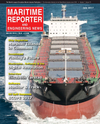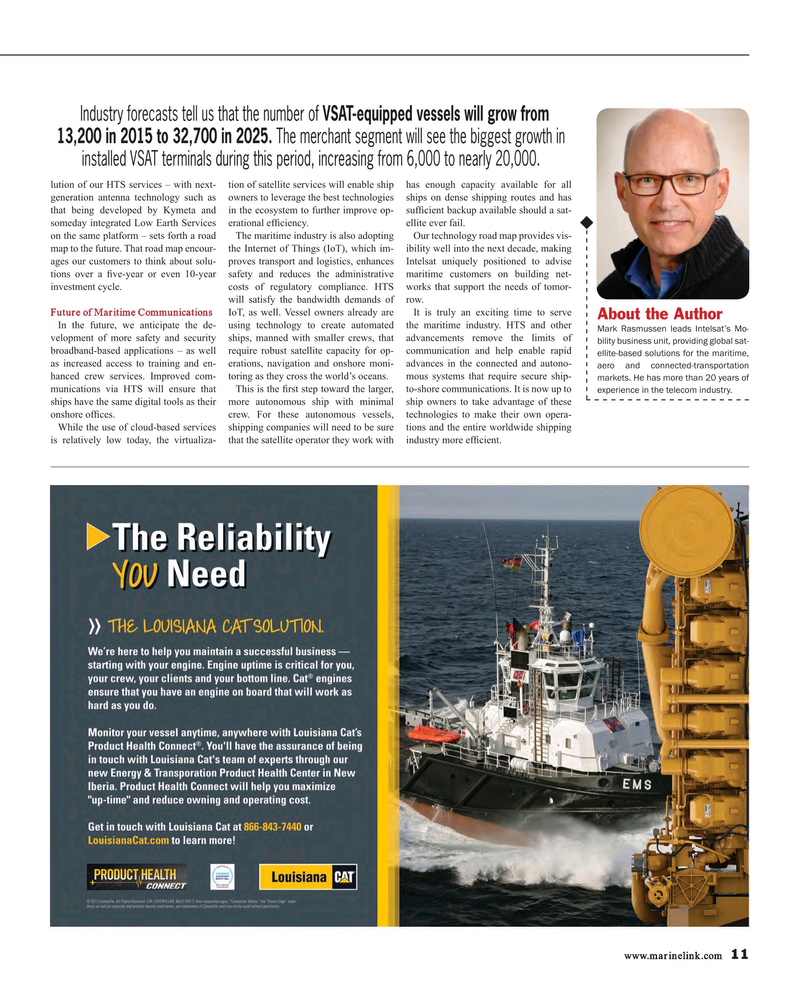
Page 11: of Maritime Reporter Magazine (July 2017)
The Marine Communications Edition
Read this page in Pdf, Flash or Html5 edition of July 2017 Maritime Reporter Magazine
Industry forecasts tell us that the number of VSAT-equipped vessels will grow from 13,200 in 2015 to 32,700 in 2025. The merchant segment will see the biggest growth in installed VSAT terminals during this period, increasing from 6,000 to nearly 20,000. lution of our HTS services – with next- tion of satellite services will enable ship has enough capacity available for all generation antenna technology such as owners to leverage the best technologies ships on dense shipping routes and has that being developed by Kymeta and in the ecosystem to further improve op- suf? cient backup available should a sat- someday integrated Low Earth Services erational ef? ciency. ellite ever fail. on the same platform – sets forth a road The maritime industry is also adopting Our technology road map provides vis- map to the future. That road map encour- the Internet of Things (IoT), which im- ibility well into the next decade, making ages our customers to think about solu- proves transport and logistics, enhances Intelsat uniquely positioned to advise tions over a ? ve-year or even 10-year safety and reduces the administrative maritime customers on building net- investment cycle. costs of regulatory compliance. HTS works that support the needs of tomor- will satisfy the bandwidth demands of row.
Future of Maritime Communications IoT, as well. Vessel owners already are It is truly an exciting time to serve
About the Author
In the future, we anticipate the de- using technology to create automated the maritime industry. HTS and other
Mark Rasmussen leads Intelsat’s Mo- velopment of more safety and security ships, manned with smaller crews, that advancements remove the limits of bility business unit, providing global sat- broadband-based applications – as well require robust satellite capacity for op- communication and help enable rapid ellite-based solutions for the maritime, as increased access to training and en- erations, navigation and onshore moni- advances in the connected and autono- aero and connected-transportation hanced crew services. Improved com- toring as they cross the world’s oceans. mous systems that require secure ship- markets. He has more than 20 years of munications via HTS will ensure that This is the ? rst step toward the larger, to-shore communications. It is now up to experience in the telecom industry.
ships have the same digital tools as their more autonomous ship with minimal ship owners to take advantage of these onshore of? ces. crew. For these autonomous vessels, technologies to make their own opera-
While the use of cloud-based services shipping companies will need to be sure tions and the entire worldwide shipping is relatively low today, the virtualiza- that the satellite operator they work with industry more ef? cient.
www.marinelink.com 11
MR #7 (10-17).indd 11 MR #7 (10-17).indd 11 7/6/2017 11:01:36 AM7/6/2017 11:01:36 AM

 10
10

 12
12
